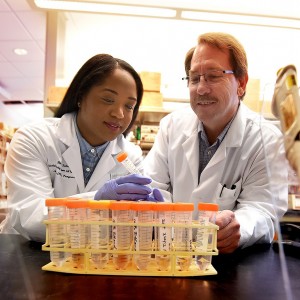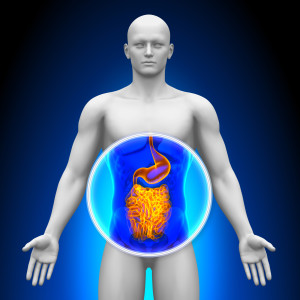
A small, daily dose of Viagra may reduce colorectal cancer risk – an article by ScienceDaily can be accessed here.
Comments from Dr. Rosenberg on the Article:
Over the last decade, researchers have elucidated the roles that impairment of cGMP signaling pathway by PDE5 activity inhibition plays in the regulation of tumor development, and progression.
PDE5 inhibition could be associated with a decreased risk of human cancer development and suppression of tumor progression in several malignancies including those of the lung, prostate, breast and colon. PDE5 inhibitors may also provide an additional anti-tumor immune response in patients affected by myeloma and head and neck squamous cell carcinomas. In addition, a synergistic effect with current chemotherapeutic regimens and monoclonal antibodies has been reported.
Although it likely will not cause harm to use PDE5 inhibitors as both a cancer preventative, as well as an adjunct to existing therapies, some questions need to be answered:
1. Which are the most effective class of PDE5 inhibitors against cancer?
2. Within each class, which drug(s) is the most effective?
3. Optimal dosage?
healthyliving December 20th, 2018
Posted In: cancer care, Cancer Prevention, Healthy Lifestyle
Tags: cancer, cancer prevention, colorectal cancer, prevention, viagra

The data linking the gut microbiome continues to accumulate. In addition, the link between an animal-based diet (meat intake) and increased cancer incidence continues to strengthen. Besides
the toxins, hormones, and sulfides associated with the intake of meat, meat contains high amounts of methionine, which has been associated with cancer proliferation.
For further reading, read the following article by Amy Wallace, which appeared in United Press International and references a study published in the journal Gut.
healthyliving September 7th, 2017
Posted In: Cancer Prevention
Tags: cancer, cancer prevention, Methionine

The Dana Farber Cancer Institute recently published an article titled, Some Head and Neck Cancer Patients Benefit From Continued Checkpoint Inhibitor Treatment after Tumor Growth.
You can read the full article here.
Response Evaluation Criteria In Solid Tumors (RECIST) is a set of published rules that define when tumors in cancer patients improve (“respond”), stay the same (“stabilize”), or worsen (“progress”) during treatment. The criteria were published in February 2000 by an international collaboration including the European Organization for Research and Treatment of Cancer (EORTC), National Cancer Institute of the United States, and the National Cancer Institute of Canada Clinical Trials Group.
Today, the majority of clinical trials evaluating cancer treatments for objective response in solid tumors use RECIST. These criteria were developed and published in February 2000, and subsequently updated in 2009. This article clearly shows that these criteria cannot be used to determine the efficacy of immunotherapy. It is not uncommon for scans, as well as the clinical picture, to worsen, with immunotherapy, before we see improvement.
Bottom line: Do not decide whether the patient should stop immunotherapy, based on the CT scan or PET scan. If the patient is doing reasonably well clinically, and is able to continue immunotherapy, continuation of therapy should be considered.
~ Dr. Rosenberg
healthyliving August 29th, 2017
Posted In: Cancer Prevention
Tags: cancer, cancer prevention, Response Evaluation Criteria

Cancer patients can work to understand and make healthy lifestyle decisions during their treatment. Adaptive and integrative cancer care practices have long advocated for integrating healthy choices about things like exercise and diet into a patient’s lifestyle.
The American Cancer Society recently shared this article by Elizabeth Mendez. The findings show that exercise may in fact, make tumors less aggressive and more likely to respond to treatment.
You can access that article here. It’s a good read for anyone faced with a cancer diagnosis, or working with cancer patients.
healthyliving May 16th, 2017
Posted In: cancer care, Cancer Prevention
Tags: cancer, cancer care, cancer prevention
Throughout the history of cancer research, in both the conventional and alternative cancer research realms, there has been a cause and effect relationship that has been largely ignored. The ability of a cell to divide, whether it be a malignant or non-malignant cell, is dependent on cell volume, as well as membrane potential. As you will learn, there is also a relationship between cell volume and membrane potential.
Cells that are cycling (dividing), progress through the following phases: G1 (Gap 1) – this is the
phase where the cell is preparing for the next phase, which is the S phase, or DNA Synthesis phase. Once DNA synthesis is complete, the cell enters the G2 phase (G 2), where it prepares to enter the final phase, called the M phase, or mitosis. During mitosis, the cell divides into 2 cells. The cell volume is at its smallest at G1, and gradually increases its volume until it reaches its largest volume in the M phase. This should be intuitive, because the cell must become large enough to divide and then support two cells.
Throughout the cell cycle, the cell is constantly monitoring the volume. If the cell does not reach the desired volumes, the cell will be unable to progress to the next phase. There is a G1/S transition “checkpoint,” which commonly causes the cell to arrest at this intermediate stage, if adequate volume is not reached. When a cell is arrested due to inadequate volume, there are two possible ensuing events: either the cell will leave the cycle and enter G0, and become a dormant, non-cycling cell, or the cell will be recognized as non-viable, and undergo mitochondrial-induced programmed cell death (apoptosis).
Interestingly, cell volume correlates with cell membrane electrical potential. Cells that are rapidly dividing are in the “depolarized” state; meaning they have less negatively charged particles in the intra-cellular space relative to the extra-cellular space. Cells that are not able to divide are “hyperpolarized;” meaning they have much greater amounts of negatively charged particles in the intra-cellular space relative to the extra-cellular space. Bottom line: Rapidly dividing cells have large volume and are depolarized, while non-dividing cells have small volume and are hyperpolarized.
healthyliving May 3rd, 2017
Posted In: Cancer Prevention
Tags: cancer, cancer care, cancer prevention, cell volume

A plethora of data exists regarding the benefits of calorie restriction. Calorie restriction has been shown to increase healthspan and lifespan in all species studied. Interestingly, calorie restriction, or intermittent fasting, has been shown to be beneficial to cancer patients undergoing chemotherapy; https://news.usc.edu/103972/fasting-like-diet-turns-the-immune-system-against-cancer/
A study led by Valter Longo, was published in the journal Cancer Cell on July 11, days after BMC Cancer published a separate study showing that a pilot trial of the three-day, fasting-like diet was “safe and feasible” for 18 cancer patients on chemotherapy. The mouse study on skin and breast cancers is the first study to show that a diet that mimics fasting may activate the immune system and expose the cancer cells to the immune system,” Longo said. The two studies’ findings build upon prior research that showed a short-term fast starves cancer cells and facilitates the chemo drug therapies to better target the cancer.
Another more recent study showed that a low-calorie, fasting-mimicking diet can slow multiple sclerosis by killing off bad cells and generating new healthy ones. The results of this latest mouse study are striking since chemotherapy’s side effects include immunosuppression. The researchers found that the fasting-mimicking diet, when used with chemotherapy drugs, raises the levels of bone marrow cells that generate immune system cells, such as T cells, B cells and “natural killer” cells that infiltrate tumors.
In the mouse study, scientists saw another significant effect of the diet: the “T regulatory” cells which protect the cancer cells were expelled. They also found three cycles of the fasting diet, combined with doxorubicin, prompted a 33 percent increase in the levels of cancer-fighting white blood cells and doubled the number of progenitor cells in the bone marrow. The cancer-killing cells were also more effective at attacking and shrinking the tumors. The research team also found that 72 hours of fasting, in patients undergoing chemotherapy, is associated with lower side effects, compared with fasting for 24 hours. This raises the possibility that a doctor-monitored, fasting-like diet could bolster the effectiveness of immunotherapy on a wider range of cancers.
You can access this study here.
~ Dr. Rosenberg
healthyliving May 2nd, 2017
Posted In: Cancer Prevention
Tags: calorie restriction, cancer, cancer prevention, fasting

The answer to this question, as I have personally learned in my practice, is to use everything that works. Unlike the pharmaceutical method, one size does not fit all. What works for one patient’s cancer may not work for the next.
Because the mechanism of progression of cancer is extremely complex and multifaceted, one must often treat with many different modalities. In addition, not only is every cancer genetically unique, but it’s constantly changing; cancer is a dynamic disease because of constant mutations.
The idea of treating everyone with the same cancer, using the same chemotherapy, is absurd to any cancer scientist. One should not even use chemotherapy without knowing the genetics of the cancer. This explains why some patients get no benefit from chemotherapy, and some get a temporary response; it’s pot luck. If you are lucky enough to get chemotherapy that fits your cancer, you may get a temporary response.
Why don’t we do genetic testing on all cancer patients? Once again, it comes down to money. Doing genetic testing on all cancer patients would be as cost-effective as making a different dose of blood pressure medicine for every individual in the country.
Here is an abbreviated summary of the drugs and modalities I use in my treatment of advanced stage cancer.
1) Immunotherapy; to stimulate the innate immune system;
a) Coley’s toxins consists of heat-killed bacteria that stimulate the innate immune system to attack abnormal cells, including cancer. GcMAF is a macrophage activating factor that is normally inhibited by cancer cells.
b) Interleukin-2 is a substance produced by the body that stimulates production of cytotoxic T cells, which can kill cancer cells.
c) Whole body hyperthermia is a process where the patient is warmed to a temperature of up to 104 degrees Fahrenheit. Increased temperature stimulates increased innate immune function.
2) Glycolytic inhibitors; DCA, or dichloroacetate inhibits the cancer cells’ ability to utilize sugar, while promoting normal mitochondrial oxidative phosphorylation (cancer cells that use oxidative phosphorylation are more susceptible to being destroyed).
3) Matrix metalloproteinase inhibitor; cancer cells “dig in” by secreting an enzyme that breaks down tissue. Low dose doxycycline inhibits release of this enzyme.
4) Angiogenesis inhibitors; tumors can not grow without sprouting new vessels. Vessel formation is dependent on adequate amounts of copper;. If copper is depleted, tumors can not develop more blood vessels. Ammonium tetrathiomolybdate, chelates copper, thereby inhibiting angiogenesis.
5) Cancer cell cytotoxic agents; vitamin C, at high doses intravenously, when used with vitamin K3 at a ratio of 100:1, is preferentially cytotoxic to cancer cells, while leaving normal cells unharmed.
6) Mitosis inhibitors; cancer cells divide rapidly through a process called mitosis. Mitosis occurs through a process known as spindle formation. During spindle formation, spindles pull the chromosomes to opposite sides of the cell, in preparation for cell division. Noscapine, an opioid agonist binds to the spindles, inhibiting mitosis.
7) Aromatase inhibitors; research has shown that several cancers, including breast, cervical, uterine, lung, and colorectal, often fuel their growth through the production of estrogen. Aromatase inhibitors block production of estrogen.
8) IGF-1; IGF-1, or insulin-like growth factor-1 is a growth factor that often fuels cancer growth. Octreotide inhibits the production of IGF-1.
9) GnRh agonists; GnRh agonists, or gonadotropin releasing hormone agonists may inhibit cancer in 2 ways. GnRh inhibits production of the sex steroids; if the cancer is dependent on sex steroids, GnRh will slow cancer growth. In addition, many cancers have receptors for GnRh, which when stimulated, inhibit cancer growth.
10) Many other drugs and natural supplements are often used as well, depending on the specifics of the patient’s cancer.
Using all of the above modalities, I have been able to cut off many pathways of cancer growth, often converting an acutely progressive disease, into a stable, chronic disease.
What will it take to awaken the masses? What will it take to educate the medical professionals that advanced stage cancer can be treated as a chronic disease right now? I do not know the answer to this question. If I knew, I would already be doing it.
In the meantime, I continue on my journey, with the minority of physicians who care to make a difference, no matter what the consequences.
~ Dr. Rosenberg
healthyliving April 18th, 2017
Posted In: cancer care, Cancer Prevention
Tags: advanced stage cancer, cancer prevention, stage iv cancer, treatment